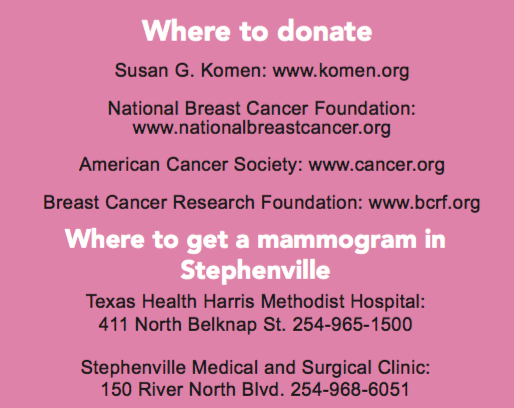What you need to know about breast cancer
October 5, 2017
October is upon us, which means that breast cancer awareness month is here. The American Cancer Society’s research shows that 70,000 people between the ages of 15 and 39 are diagnosed with breast cancer each year. That’s you, traditional college students! Here are some facts that could affect you, according to the American Cancer Society:
• Women are recommended to seek out clinical breast exams beginning at age 20, and continue to every three years until age 40.
• After 40, a yearly mammogram is recommended.
• Statistically, 1 in 8 women will be diagnosed with breast cancer.
• 1% of all breast cancer diagnoses are men.
• 31% of all cancer diagnoses are in people ages 15-39.
Junior nursing 1 student, Cassidy Womack, said “We just went over clinical breast exams and self-exams in my Assessment class. We mostly learn about visual symptoms, such as dimpling, nipple inversion and something called ‘peau d’orange,’ which resembles the texture of an orange peel on the skin of the breast. We also learned how to teach the proper way to conduct a self-exam.”
Womack also said, “A general good rule of thumb is that if you suspect something is up, see a health care professional. Sudden changes in general breast shape or feel can definitely indicate something and should be evaluated by a professional.”
She also added that, although they are not anything to worry about, fibrocystic breasts are common in women ages 20-50. This means that the breast tissue feels lumpy or rope-like. However, don’t just shrug off a bump you may feel as this symptom; see a professional if you have any concerns.
According to the American Cancer Society, there are some lifestyle-related factors that you can change to lower your risk of being diagnosed. Avoiding the consumption of alcohol, maintaining a healthy weight, being physically active, having children and researching your birth control are all ways that you can cancel out some risks.
Lisa Riley, a registered nurse at the Tarleton State University Health Center, shared some tips on how to give yourself a proper self-exam.
“Habits are formed at a very early age. It is very important to begin self-breast exams monthly,” Riley said. “This should be done at the same time every month and should include under the arm, where the lymph nodes are.
“Self-exams should be done in a circular motion beginning at the nipple area using the flat portion of the fingers. Using a rolling method, slowly move from the nipple around the breast, moving outward in a circular pattern. The self- exam should include all the breast tissue and then extend under the arm. Being familiar with how your individual breast tissue feels will help you to know if there are changes in the feel or appearance of the breast.”
The Tarleton Health Center supports awareness by passing out stickers, pins, and self-breast exam guides.
“We welcome students that show their support; we also wear pink to show our support,” Riley says. “Come by and pick up a pin, sticker, or exam guide.”
If you would like to donate to the research of breast cancer, consider these credible organizations in the above infographic.



